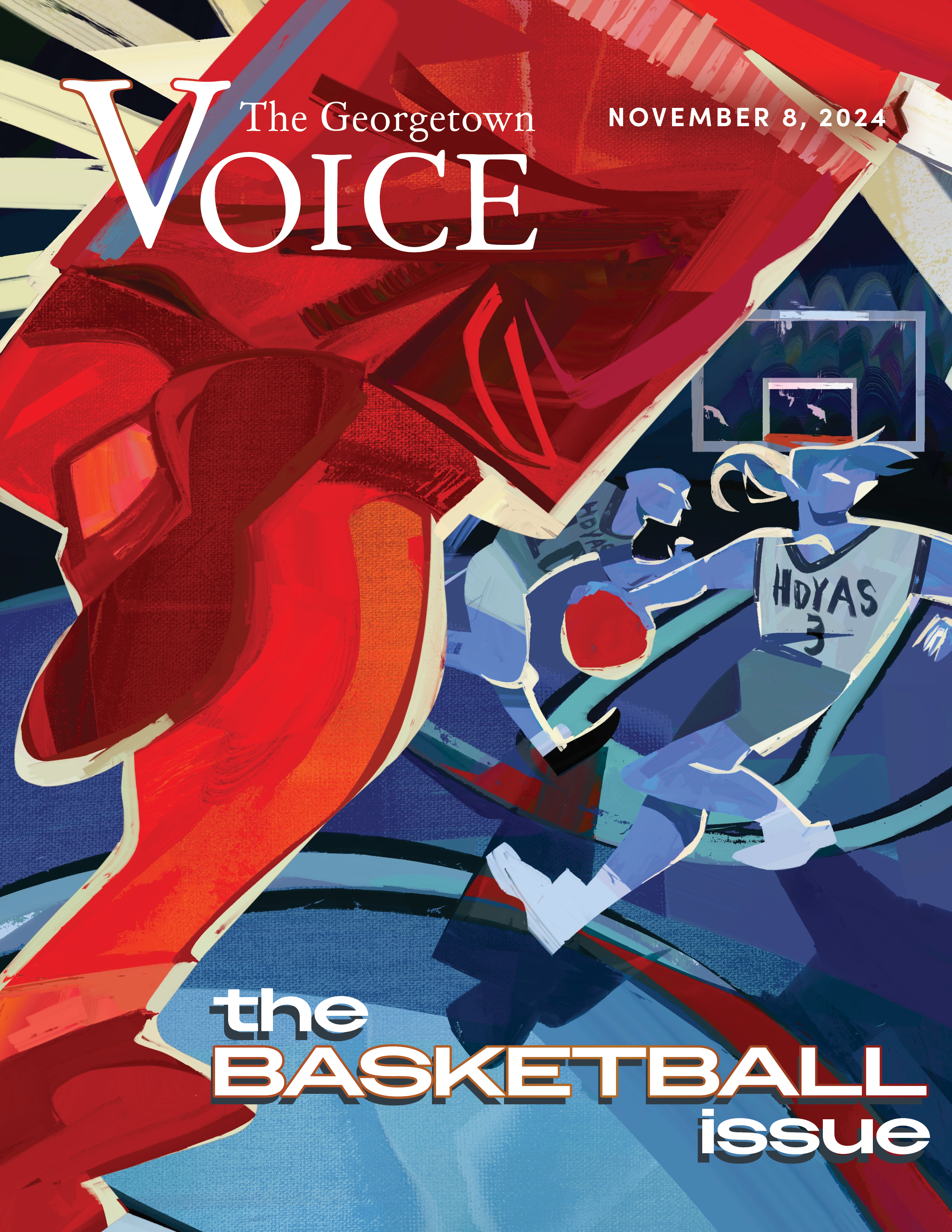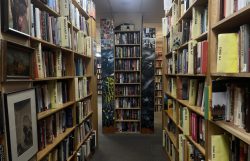When Steven Singer was hired as a professor of biology in 1999, he was told that Georgetown would have a new science building within five years. Other professors hired earlier in the ‘90s were told the same thing.
“It was always ‘in five years,’” Singer, now chair of the biology department, said.
In fact, construction on the new science center didn’t begin until more than a decade after Singer’s hiring. These days, though, it is easy to see the progress being made on the building, which is scheduled to open in the fall of 2012. An imposing steel frame now stands where for years there was only a patch of dirt, and construction workers are busy transforming the nearly $100 million building from blueprint to reality.
But despite the visible progress, many biology, chemistry, and physics faculty members still question whether the University is truly committed to improving its science departments.
The crux of the issue is size. Reiss Science Center is full to capacity, yet Georgetown’s science programs are still dramatically smaller than those of peer institutions. The small faculty size means fewer graduate students, a limited research scope, and inadequate teaching capacity. To address this deficiency, the University has publicly committed to creating an additional 35 positions within the natural sciences, but finding space for new professors has turned into a logistical catch-22.
The new science center was built because Reiss is no longer usable. But at 155,000 square feet, the new science center is approximately the same size as Reiss—meaning it will be able to house current science faculty but no new hires. Renovating Reiss is at the top of the science programs’ wish list, but no timetable has been set for the project, leaving science department chairs uneasy about hiring new faculty.
“The thing that has held me up is that until we know when Reiss is going to be renovated, there’s not a lot of point in talking about recruiting new faculty because I don’t know when we’ll be able to put them somewhere,” Singer said.
It was the degenerating state of Reiss that prompted science faculty members to push for a new science facility. The building is full to the brim, with the biology department forced to house two of its professors’ offices in the observatory across campus. Built in 1962 during the post-Sputnik science boom, Reiss’s faltering infrastructure attests to the building’s age. Singer said professors routinely deal with problems such as failing temperature and humidity control systems and frequent water leaks that limit their capacity to conduct research there.
In one biology experiment involving the development of frog embryos, the researchers had to use freestanding temperature control units because they couldn’t get the air conditioning system to maintain the desired temperature of 68 degrees, Singer said.
Makarand Paranjape, a professor in the physics department and a member of the Science Center Planning Committee, said that a few years ago one of his colleagues was doing an experiment that involved toxic chemicals and the fume hood he was using malfunctioned, blowing the chemicals out into the lab rather than absorbing them.
“The situation is getting ridiculous,” Paranjape said. “We have … such poor facilities, and no one is doing anything to change that. The voices [from the science faculty] became louder. They must have been heard by the right people.”
In addition to infrastructure issues, Reiss’s spatial layout is ill-suited to modern science research. While the new science center is designed with plenty of common spaces and larger, more open labs to facilitate interdisciplinary interaction, Reiss follows a silo model, with small labs distributed throughout the building in isolated pockets. The conference spaces are also “miserable,” according to Singer. Former physics department chair and Science Center Planning Committee member Jeff Urbach said that this “inflexible” design is hard to change without full-scale renovations because the labs are surrounded by concrete walls.
The poor design and infrastructure problems create an overall impression that the building is “outdated,” according to Vice President for Facilities and Student Housing Karen Frank. Paranjape said that when freshmen enter the labs in Reiss for the first time, many comment that the facilities at their high schools were much nicer.
“I’m sure it was state of the art at the time [it was built], but it doesn’t have enough support for research and the ideas for what were most appropriate for research back in the ‘60s are not the same as today,” Associate Provost for Academics Marjorie Blumenthal said. “And most importantly the core infrastructure of the building has degraded after decades. … The basic issue was that the building is not functioning well.”
The overall inadequacy of the facilities at Reiss, along with significant lobbying from the science faculty, convinced the University administration to finally make good on their promise of a new science building.
“You can’t expect a building built in the 1960s to be adequate for the science of the 21st century,” Associate Provost for Research and Dean of the Graduate School Timothy Barbari wrote in an email. “Georgetown was significantly behind our peers in new facilities and the potential of system-wide failure of internal infrastructure to support research in Reiss was becoming greater. … We could no longer ignore the state of our science facilities.”
Faculty members in all three science departments formed the Science Center Planning Committee to determine and articulate their priorities for the new building. According to Paranjape, the group took a number of field trips to see how other universities had built modern science facilities. The committee’s highest priorities were making sure the building would support the principal research activities of Georgetown professors, prioritizing flexible spaces, and in the words of Blumenthal, ensuring that the new facility was filled with “stuff that works.”
As many of the people involved in the planning process were knowledgeable about environmental science, there was also a push to make the new building energy efficient. Because science facilities require a high level of water and power usage for experiments, it is very difficult to make them environmentally friendly. But by working with outside consultants, the University was able to design the building to meet Leadership in Energy and Environmental Design’s silver certificate standards.
Although construction of the new building was scheduled to start in 2008, the project was delayed by the financial crisis late that year, which made securing the necessary loans difficult. Construction was jumpstarted in January 2010 when Georgetown obtained a $6.9 million grant from the National Institute of Standards and Technology as part of the American Recovery and Reinvestment Act of 2009. The grant, which specifically funds an Institute of Soft Matter Synthesis and Metrology that will be housed in the new science center, requires that the project be completed by 2012.
While the new science center will primarily be a research facility, two of its five floors will be used as teaching space, mostly in the form of teaching laboratories. The rest of the building will be dedicated to professors’ offices and “wet” lab space, laboratories for experiments involving chemicals or biological materials rather than just computational or theoretical research. The layout for these labs will be dramatically different from the current set-up in Reiss.
“The research labs will be very large, open spaces,” Singer said. “Three to five research groups will be in the same room. Now [in Reiss] one group may be in three different rooms. The open lab design … generates a lot of energy. It’s easier if you’re in there at 8 at night and there are five other people. It’s a lot more pleasant, more interactive.”
The open lab concept is one of many ways in which the new building is designed to encourage interdisciplinary contact. Instead of dedicating one floor to each of the three science departments, professors’ offices will be grouped together by subject matter rather than by department. Like the Hariri building, the new science center will boast plenty of common areas, which will feature ample seating and white boards, to foster more casual interaction between faculty members and students and more interdisciplinary endeavors like the Soft Matter Institute, a collaboration between members the physics and chemistry departments.
Many students were enthusiastic about this new focus on interdisciplinary interaction.
“In medical schools, there’s been a huge shift over the last five years to an integrated, problem-based approach,” Matt Pacana (NHS ’12) said. “I feel like that’s something that the undergraduate level needs to come around to, the idea of integrating multiple subjects.”
The administration is also enthusiastic about the idea, particularly because the small size of Georgetown’s science programs gives them a competitive advantage in interdisciplinary fields.
“Because of our scale, it’s actually easier for us to explore interdisciplinary areas than when you’re at some of the larger research powerhouses where the individual departments can be so large that people tend to work more among their own kind,” Blumenthal said.
But for all the new building’s advantages, it is smaller than some on the planning committee would have liked.
“I think [the major priorities] were all included and addressed to a large extent, but there’s only so much space and so many dollars,” Urbach said. “Of course we wanted more space, [but] that had to be worked in to the budget constraints.”
The fact that the new building has the same capacity as Reiss leaves the science chairs unsure of how to proceed with their next major goal: expanding the size of the science faculty. Each of Georgetown’s science programs has only about 15 professors, but Singer said that when he looked into biology programs at similarly situated schools, the next smallest department had 21 professors.
Fewer professors means fewer research projects and less grant money for the University.
“The sciences are by nature research-intensive, their research footprint tends to be larger,” Urbach said. “Having small sciences makes Georgetown’s overall research footprint smaller, and that hurts our international profile.”
Besides limiting research output, the small faculty size also puts a cap on the size and strength of Georgetown’s graduate programs in the sciences. All three departments would like to increase the number of graduate students they train, but that will be a tall order without more faculty to supervise them.
Additionally, the small size of the departments—and, by extension, the limited number of research projects—makes Georgetown a less attractive option for potential science graduate students.
“When the size of the department is small, that acts as a detriment in some sense,” said Steven Ryckbosch (COL ’11), who is planning on going to graduate school for chemistry.
Some undergraduates, like Alisse Hannaford (COL ’13), like the small size of the faculty because it allows them to have personal interaction with many of the top professors in their field. But a larger science faculty would also have positive implications for the undergraduate science experience, such as fewer courses taught by adjunct professors and greater opportunities to participate in research. The current process for getting involved with research as an undergraduate is “cumbersome,” according to Mukherjee, because there are so few open spots.
More science professors would also allow Georgetown to move forward on what has been one of its major intellectual priorities since 2009: incorporating a science requirement into the core curriculum for the SFS and MSB. There are not currently enough faculty to meet the demand that would arise if all SFS and MSB students were required to take science courses.
“Everything is tied together,” YuYe Tong, chair of the chemistry department, said. “If you want to increase the teaching load in general, you need to increase the faculty line and you need a new space.”
Given the infrastructural inadequacies of the building, many administrators and science faculty members believe a full-scale renovation of Reiss is immediately necessary.
“To truly advance our science vision, Reiss must be basically gutted and rebuilt on the upper floors to mirror the flexible, modular ‘look and feel’ of the [new science center],” Barbari wrote in an email. “From my perspective, Reiss should be renovated as soon as the faculty vacate and occupy the new facility. Any significant delay in that timeline would only delay building our science programs to be closer in size and scope to our peers.”
There is a campaign mounting to start renovations on Reiss as soon as the new science center has opened. While Barbari says that renovating Reiss is “very high” on the upper administration’s list of priorities, he and Blumenthal confirmed that there is not yet an official timeline for the project.
Without such a commitment, some are skeptical about whether an immediate renovation of Reiss is in the cards. Paranjape says he has made small bets—wagering a cup of coffee—with colleagues about when the renovations will actually occur. He believes the project won’t be completed for at least five years.
“I’m probably being a little optimistic with five years … it may never happen,” Paranjape said. “They wanted to see a renovation such that if someone’s in Reiss or the new building, they can’t tell. That’s all well and good, but I’m not sure it’s realistic.”
It is hard to say how realistic plans for renovating Reiss are—in addition to the absence of a timeline, there are also no official cost projections, according to Frank. Wayne Davis, president of the Faculty Senate, estimated that renovation would cost at least $50 million and complete teardown and rebuild would cost at least $100 million. The price tag is steep, especially since the University just spent nearly $100 million on the new science center and will be spending approximately an additional $6 million per year for the new building’s annual operating budget, according to Davis. Any new hires will come with further expenses, since new researchers often need as much as a million dollars in start-up funds, Paranjape said.
While Blumenthal believes the new science center shows that the University recognizes the need to correct “historic deficiencies” in the sciences, the University’s finance subcommittee may be leery of undertaking another major project for the main campus right away.
“You cannot have a research university that is only strong and effective in social science and humanities—you have to have the natural sciences,” Blumenthal said. “But from time to time, in a resource constrained environment, there’s a bit of turn taking. … If the institution decides we’re going to do this for the main campus, it means we’re not doing something else.”
Given the uncertainty about the future of Reiss, it is hard to say what the new science center means for the future of science at Georgetown. Some, like Singer, believe that “there is a commitment on campus to treat the sciences with respect.”
But others aren’t so sure. Tong, for example, sees the new building as simply “paying down the debt.”
“In terms of the future of sciences at Georgetown, sustainability is more important than a one-time investment,” Tong said. “The [new] building would be a one time investment if [there is] no sustainable investment in the sciences in the future, for instance, renovating the Reiss science building.”
Still, with the new building set to open next year, optimism for the future of science at Georgetown runs high.
“Other parts of campus have made great strides and grown significantly over the last 50 years,” Singer said. “Now it’s our turn.”






The Science Center is not the same size as Reiss. It’s nearly 15% larger. That, coupled with the much better design and more efficient use of space would lead one to think it is, perhaps, 25% more useful (total guestimate there). That’s not “approximately the same size.”
The sciences can live with their $100 million building until we get a student center.